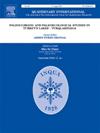加拿大北温哥华岛晚更新世植被与气候史:科迪勒兰冰盖太平洋边缘去冰生态的时空变化
IF 1.8
3区 地球科学
Q3 GEOGRAPHY, PHYSICAL
引用次数: 0
摘要
通过对加拿大温哥华岛北部6个岩心的古生态分析,揭示了更新世晚期至全新世早期科迪勒兰冰盖与太平洋交界区植被对气候变化的非同步响应。我们描述了植被的快速变化,并将其定义为一个区域孢粉地层序列:非乔木草本-灌木带、松(松)带、桤木-云杉混合带、铁杉(铁杉)带、桤木(桤木)和针叶树带。在西海岸外,寒冷干燥的非树木草原苔原最早在约1.8万年前形成,后来出现在东部,并一直持续到约1.41万年前。大约16000年前,在凉爽和相对干燥的条件下,松树在西部短暂地占主导地位,逐渐向东扩散,并在大约14300 - 14100年前在大多数地点占主导地位。降水随后增加,红/绿桤木和锡特卡云杉(Picea sitchensis)是西部地区的关键物种,在约15700年前处于温和湿润的条件下,然后在约13900 - 13600年前扩散到东部地区。西部铁杉在约13800年前和东部约13200 - 12900年前的潮湿和较冷的条件下占主导地位,温度下降约1-2°C。大约12200年前,在大多数地点,潮湿和日益温暖的环境导致了锡特卡云杉林,红桤木和西部铁杉遍布大部分地区。在更新世末期,随着内陆冰层的消退和气候的稳定,降水带向东移动和海洋的影响可能导致了植被的历时性发育。我们表明,在温哥华岛北部晚冰期的短距离内,不同的生态系统存在。此外,我们还证实了北太平洋冰期气候事件的时间和特征,包括西库事件1和温和降温事件的早期开始,该事件比北大西洋新仙女木事件至少早200-600年,并将其暂定为“Quatsino事件”。我们的研究结果表明,在研究海洋和大气系统的遥相关时,了解与全球气候主要组成部分(如北太平洋)相邻的海岸-大陆界面区域植被和气候历史的重要性。本文章由计算机程序翻译,如有差异,请以英文原文为准。
Late Pleistocene vegetation and climate history of northern Vancouver Island, Canada: spatiotemporal variation in deglacial ecology along the Pacific margin of the Cordilleran Ice Sheet
Palaeoecological analysis of six cores on northern Vancouver Island, Canada, reveals asynchronous vegetation responses to climatic changes at the interface of the Cordilleran Ice Sheet and the Pacific Ocean during the terminal Pleistocene and earliest Holocene. We describe rapid vegetation shifts and define them in a regional palynostratigraphic sequence: the Non-Arboreal Herb-Shrub Zone, the Pinus (pine) Zone, the Mixed Alnus-Picea (alder-spruce) Zone, the Tsuga (hemlock) Zone, and the Alnus (alder) and Conifer Zone. On the outer west coast, cold and dry non-arboreal steppe-tundra was established first by ∼18,000 years ago, appearing later to the east and persisting there as late as ∼14,100 years ago. Pine dominated briefly in the west at ∼16,000 years ago under cool and relatively dry conditions, spreading progressively eastward and predominating at most sites by ∼14,300–14,100 years ago. Precipitation subsequently increased, with red/green alder and Sitka spruce (Picea sitchensis) as key species in the west from ∼15,700 years ago under moderate and moist conditions before spreading to eastern sites by ∼13,900–13,600 years ago. Western hemlock dominated under moist and cooler conditions by ∼13,800 years ago in the west and ∼13,200–12,900 years ago in the east as temperatures declined ∼1–2 °C. By ∼12,200 years ago at most sites, moist and increasingly warm conditions resulted in Sitka spruce forest with red alder and western hemlock across most of the region. Diachronous vegetation development may have resulted from an eastward-shifting band of precipitation and oceanic influence as ice retreated inland and climate stabilized at the end of the Pleistocene. We show that varied ecosystems existed across short distances throughout the late-glacial interval on northern Vancouver Island. Furthermore, we corroborate the timing and character of deglacial climatic episodes in the North Pacific Ocean, including Siku Event 1 and the early onset of a mild cooling event which pre-dated North Atlantic Younger Dryas by at least 200-600 years—here assigned the provisional name “Quatsino Event”. Our results demonstrate the importance of understanding regional vegetation and climatic histories at coast-continent interfaces adjacent to major components of global climate such as the North Pacific Ocean when investigating the teleconnections of oceanic and atmospheric systems.
求助全文
通过发布文献求助,成功后即可免费获取论文全文。
去求助
来源期刊

Quaternary International
地学-地球科学综合
CiteScore
5.60
自引率
4.50%
发文量
336
审稿时长
3 months
期刊介绍:
Quaternary International is the official journal of the International Union for Quaternary Research. The objectives are to publish a high quality scientific journal under the auspices of the premier Quaternary association that reflects the interdisciplinary nature of INQUA and records recent advances in Quaternary science that appeal to a wide audience.
This series will encompass all the full spectrum of the physical and natural sciences that are commonly employed in solving Quaternary problems. The policy is to publish peer refereed collected research papers from symposia, workshops and meetings sponsored by INQUA. In addition, other organizations may request publication of their collected works pertaining to the Quaternary.
 求助内容:
求助内容: 应助结果提醒方式:
应助结果提醒方式:


